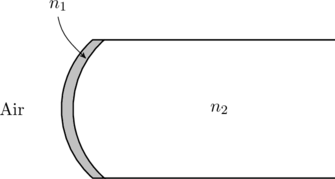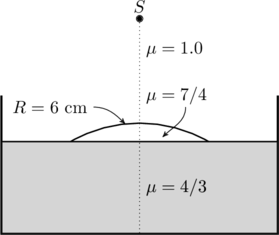JEE Advanced 2014 Paper 1, Question 9
A transparent thin film of uniform thickness and refractive index ![]() is coated on the convex spherical surface of radius
is coated on the convex spherical surface of radius ![]() at one end of a long solid glass cylinder of refractive index
at one end of a long solid glass cylinder of refractive index ![]() , as shown in the figure. Rays of light parallel to the axis of the cylinder traversing through the film from air to glass get focused at distance
, as shown in the figure. Rays of light parallel to the axis of the cylinder traversing through the film from air to glass get focused at distance ![]() from the film, while rays of light traversing from glass to air get focused at distance
from the film, while rays of light traversing from glass to air get focused at distance ![]() from the film. Then
from the film. Then

Related Problem: Lensing by oil on water
Solution
We can solve this problem using …

